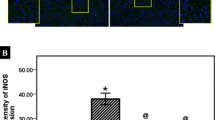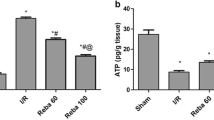Abstract
Background
Oxidative stress and inflammation play a key role in the development of hepatic ischemia reperfusion (HIR)-induced injury. Nuclear factor-erythroid 2-related factor-2 (Nrf-2) is a main regulator of numerous genes, encoding cytoprotective molecules including heme oxygenase-1 (HO-1). Sitagliptin (Sit) is an incretin enhancer acting via inhibition of dipeptidyl peptidase-4 (DPP-4) enzyme. This study was undertaken to investigate the ability of Sit to prevent the hepatic pathological changes of HIR induced injury and to modify Nrf-2 and its target HO-1.
Methods
Pringle’s maneuver was used to induce total HIR in adult male rats that were randomly assigned into 4 groups. Groupl (sham-operated control), Group 2 (sham-operated + Sit-control group), Group 3 (HIR non-treated), and Group 4 (HIR+Sit). Alanine aminotransferase (ALT) and aspartate aminotransferase (AST) activities together with hepatic contents of malondialdhyde (MDA), nitric oxide (NO) and reduced glutathione (GSH) and superoxide dismutase (SOD) activity were evaluated. Hepatic tissue mRNA of Nrf-2 and protein content of HO-1 along with histopathological examination and scoring of hepatic injury were performed.
Results
Sit caused a significant reduction in ALT and AST activities together with attenuation of HIR-induced histopathological liver injury. Effect of Sit was associated with decreased hepatic level of MDA and NO with increased GSH level and SOD activity. Non-treated rats with HIR showed an increase in Nrf-2 mRNA expression and HO-1 content in hepatic tissue which was further increased by Sit treatment.
Conclusions
These results indicate that hepatoprotective activity of Sit against HIR is attributed at least in part to modulation of Nrf-2/HO-1 signaling pathway.
Similar content being viewed by others
References
Osman AS, Osman AH, Kamel MM. Study of the protective effect of ischemic and pharmacological preconditioning on hepatic ischemic reperfusion injury induced in rats. JGH Open 2017;1(3):105–11.
Bektas S, Karakaya K, Can M, Bahadir B, Guven B, Erdogan N, et al. The effects of tadalafil and pentoxifylline on apoptosis and nitric oxide synthase in liver ischemia/reperfusion injury. Kaohsiung J Med Sci 2016;32(7):339–47.
Atef Y, El-Fayoumi HM, Abdel-Mottaleb Y, Mahmoud MF. Quercetin and tin protoporphyrin attenuate hepatic ischemia reperfusion injury: role of HO-1. Naunyn Schmiedebergs Arch Pharmacol 2017;390(9):871–81.
Lee JM, Li J, Johnson DA, Stein TD, Kraft AD, Calkins MJ, et al. Nrf2, a multi-organ protector? FASEB J 2005;19(9):1061–6.
Masuda Y, Vaziri ND, Takasu C, Li S, Robles L, Pham C, et al. Salutary effect of pre-treatment with an Nrf2 inducer on ischemia reperfusion injury in the rat liver. Gastroenterol Hepatol (Que) 2014;1(1):1–7.
Ke B, Shen XD, Zhang Y, Ji H, Gao F, Yue S, et al. KEAP1-NRF2 complex in ischemia-induced hepatocellular damage of mouse liver transplants. J Hepatol 2013;59(6):1200–7.
Nishikawa Y, Stepp DW, Merkus D, Jones D, Chilian WM. In vivo role of heme oxygenase in ischemic coronary vasodilation. Am J Physiol Heart Circ Physiol 2004;286(6):H2296–304.
Zhang GY, Wang DD, Cao Z, Wei T, Liu CX, Wei QL. Sitagliptin ameliorates high glucose-induced cell proliferation and expression of the extracellular matrix in glomerular mesangial cells. Exp Ther Med 2017;14(4):3862–7.
Drucker DJ. Dipeptidyl peptidase-4 inhibition and the treatment of type 2 diabetes: preclinical biology and mechanisms of action. Diabetes Care 2007;30 (6):1335–43.
Picatoste B, Ramirez E, Caro-Vadillo A, Iborra C, Ares-Carrasco S, Egido J, et al. Sitagliptin reduces cardiac apoptosis, hypertrophy and fibrosis primarily by insulin-dependent mechanisms in experimental type-II diabetes. Potential roles of GLP-1 isoforms. PLoS One 2013;8(10)e78330.
Geddawy A, Hussian M, Kamel MY, Kamal R, Ibrahim MA. Effects of Liraglutide and vitamin e in fructose-induced metabolic syndrome in rats. Pharmacology 2017;99(1-2):48–56.
Ibrahim MA, Geddawy A, Abdel-Wahab S. Sitagliptin prevents isoproterenol- induced myocardial infarction in rats by modulating nitric oxide synthase enzymes. Eur J Pharmacol 2018;829:63–9.
Trocha M, Nowak B, Merwid-Lad A, Szuba A, Dziegiel P, Piesniewska M, et al. The impact of sitagliptin, inhibitor of dipeptidyl peptidase-4 (DPP-4), on the ADMA-DDAH-NO pathway in ischemic and reperfused rat livers. Adv Clin Exp Med 2018;27(11):1483–90.
Tang ST, Su H, Zhang Q, Tang HQ, Wang CJ, Zhou Q, et al. Sitagliptin inhibits endothelin-1 expression in the aortic endothelium of rats with streptozotocin- induced diabetes by suppressing the nuclear factor-kappaB/IkappaBalpha system through the activation of AMP-activated protein kinase. Int J Mol Med 2016;37(6):1558–66.
Abdel-Gaber SA, Ibrahim MA, Amin EF, Ibrahim SA, Mohammed RK, Abdelrahman AM. Effect of selective versus non-selective cyclooxygenase inhibitors on ischemia-reperfusion-induced hepatic injury in rats. Life Sci 2015;134:42–8.
Buege JA, Aust SD. Microsomal lipid peroxidation. Methods Enzymol 1978;52:302–10.
Marklund S, Marklund G. Involvement of the superoxide anion radical in the autoxidation of pyrogallol and a convenient assay for superoxide dismutase. Eur J Biochem 1974;47(3):469–74.
Moron MS, Depierre JW, Mannervik B. Levels of glutathione, glutathione reductase and glutathione S-transferase activities in rat lung and liver. Biochim Biophys Acta 1979;582(1):67–78.
Green LC, Wagner DA, Glogowski J, Skipper PL, Wishnok JS, Tannenbaum SR. Analysis of nitrate, nitrite, and [15N]nitrate in biological fluids. Anal Biochem 1982;126(1):131–8.
VanGuilder HD, Vrana KE, Freeman WM. Twenty-five years of quantitative PCR for gene expression analysis. Biotechniques 2008;44(5):619–26.
Wei Y, Chen P, de Bruyn M, Zhang W, Bremer E, Helfrich W Carbon monoxide-releasing molecule-2 (CORM-2) attenuates acute hepatic ischemia reperfusion injury in rats. BMC Gastroenterol 2010; 10:42.
Guan LY, Fu PY, Li PD, Li ZN, Liu HY, Xin MG, et al. Mechanisms of hepatic ischemia-reperfusion injury and protective effects of nitric oxide. World J Gastrointest Surg 2014;6(7):122–8.
Cannistra M, Ruggiero M, Zullo A, Gallelli G, Serafini S, Maria M, et al. Hepatic ischemia reperfusion injury: a systematic review of literature and the role of current drugs and biomarkers. Int J Surg 2016;33(Suppl. 1):S57–70.
Ibrahim MA, Abdel-Gaber SA, Amin EF, Ibrahim SA, Mohammed RK, Abdelrahman AM. Molecular mechanisms contributing to the protective effect of levosimendan in liver ischemia-reperfusion injury. Eur J Pharmacol 2014;741:64–73.
Mard SA, Akbari G, Dianat M, Mansouri E. The effect of zinc sulfate on miR-122, miR-34a, atioxidants, biochemical and histopathological parameters following hepatic Ischemia/Reperfusion injury in rats. Biol Trace Elem Res 2019; 188 (2):434–40.
Huang XL, He Y, Ji LL, Wang KY, Wang YL, Chen DF, et al. Hepatoprotective potential of isoquercitrin against type 2 diabetes-induced hepatic injury in rats. Oncotarget 2017;8(60):101545–59.
Sokar SS, El-Sayad ME, Ghoneim ME, Shebl AM. Combination of Sitagliptin and Silymarin ameliorates liver fibrosis induced by carbon tetrachloride in rats. Biomed Pharmacother 2017;89:98–107.
Cutrin JC, Llesuy S, Boveris A. Primary role of Kupffer cell-hepatocyte communication in the expression of oxidative stress in the post-ischaemic liver. Cell Biochem Funct 1998;16(1):65–72.
Siriussawakul A, Zaky A, Lang JD. Role of nitric oxide in hepatic ischemia-reperfusion injury. World J Gastroenterol 2010;16(48):6079–86.
Abdel-Gaber SA, Mohammed RK Refaie MMM. Mechanism mediating the protective effect of diacerein in ischemia-reperfusion-induced testicular injury in rats. Life Sci 2018;209:57–62.
El-Sheikh AA, Morsy MA, Hamouda AH. Protective mechanisms of thymoquinone on methotrexate-induced intestinal toxicity in rats. Pharmacogn Mag 2016;12(Suppl. 1):S76–81.
Kannan K, Jain SK. Oxidative stress and apoptosis. Pathophysiology 2000;7 (3):153–63.
Civantos E, Bosch E, Ramirez E, Zhenyukh O, Egido J, Lorenzo O, et al. Sitagliptin ameliorates oxidative stress in experimental diabetic nephropathy by diminishing the miR-200a/Keap-l/Nrf2 antioxidant pathway. Diabetes Metab Syndr Obes 2017;10:207–22.
Liu L, Liu J, Tian XY, Wong WT, Lau CW, Xu A, et al. Uncoupling protein-2 mediates DPP-4 inhibitor-induced restoration of endothelial function in hypertension through reducing oxidative stress. Antioxid Redox Signal 2014;21(11):1571–81.
Abo-Haded HM, Elkablawy MA, Al-Johani Z, Al-Ahmadi O, El-Agamy DS. Hepatoprotective effect of sitagliptin against methotrexate induced liver toxicity. PLoS One 2017;12(3)e0174295.
Chen M, Jiang L, Li Y, Bai G, Zhao J, Zhang M, et al. Hydrogen protects against liver injury during C02 pneumoperitoneum in rats. Oncotarget 2017;9(2):2631–45.
Ungvari Z, Bagi Z, Feher A, Recchia FA, Sonntag WE, Pearson K, et al. Resveratrol confers endothelial protection via activation of the antioxidant transcription factor Nrf2. Am J Physiol Heart Circ Physiol 2010;299(1):H18–24.
Lee D, Kook SH, Ji H, Lee SA, Choi KC, Lee KY, et al. N-acetyl cysteine inhibits H202-mediated reduction in the mineralization of MC3T3-E1 cells by down-regulating Nrf2/HO-1 pathway. BMB Rep 2015;48(11):636–41.
Morse D, Lin L, Choi AMK, Ryter SW Heme oxygenase-1, a critical arbitrator of cell death pathways in Jung injury and disease. Free Radic Biol Med 2009;47(1):1–12.
Leffler CW, Nasjletti A, Yu C, Johnson RA, Fedinec AL, Walker N. Carbon monoxide and cerebral microvascular tone in newborn pigs. Am J Physiol 1999;276(5):H1641–6.
Otterbein LE, Soares MP, Yamashita K, Bach FH. Heme oxygenase-1: unleashing the protective properties of heme. Trends Immunol 2003;24(8):449–55.
Osburn WO, Wakabayashi N, Misra V, Nilles T, Biswal S, Trush MA, et al. Nrf2 regulates an adaptive response protecting against oxidative damage following diquat-mediated formation of superoxide anion. Arch Biochem Biophys 2006;454(1):7–15.
Kudoh K, Uchinami H, Yoshioka M, Seki E, Yamamoto Y Nrf2 activation protects the liver from ischemia/reperfusion injury in mice. Ann Surg 2014;260(1):118–27.
Osburn WO, Yates MS, Dolan PD, Chen S, Liby KT, Sporn MB, et al. Genetic or pharmacologic amplification of nrf2 signaling inhibits acute inflammatory liver injury in mice. Toxicol Sci 2008;104(1):218–27.
Chen J, Liu H, Zhang X. [Protective effects of rosiglitazone on hepatic ischemia reperfusion injury in rats]. Zhong Nan Da Xue Xue Bao Yi Xue Ban 2018;43 (7):732–7.
Shimada S, Fukai M, Wakayama K, Ishikawa T, Kobayashi N, Kimura T, et al. Hydrogen sulfide augments survival signals in warm ischemia and reperfusion of the mouse liver. Surg Today 2015;45(7):892–903.
Patel A, Zhang S, Shrestha AK, Maturu P, Moorthy B, Shivanna B. Omeprazole induces heme oxygenase-1 in fetal human pulmonary microvascular endothelial cells via hydrogen peroxide-independent Nrf2 signaling pathway. Toxicol Appl Pharmacol 2016;311:26–33.
Wang CH, Zhu N. Protective role of sitagliptin against oxidative stress in a kainic acid-induced status epilepticus in rats models via Nrf2/HO-1 pathway. Drug Dev Res 2019.
Wang J, Hu L, Chen Y, Fu T, Jiang T, Jiang A, et al. Sitagliptin improves renal function in diabetic nephropathy in male Sprague Dawley rats through upregulating heme oxygenase-1 expression. Endocrine 2019;63(1):70–8.
Chang MW, Chen CH, Chen YC, Wu YC, Zhen YY, Leu S, et al. Sitagliptin protects rat kidneys from acute ischemia-reperfusion injury via upregulation of GLP-1 and GLP-1 receptors. Acta Pharmacol Sin 2015;36(1):119–30.
Chua S, Lee FY, Tsai TH, Sheu JJ, Leu S, Sun CK et al. Inhibition of dipeptidyl peptidase-IV enzyme activity protects against myocardial ischemia-reperfusion injury in rats. J Transl Med 2014;12:357.
Turkseven S, Kruger A, Mingone CJ, Kaminski P, Inaba M, Rodella LF, et al. Antioxidant mechanism of heme oxygenase-1 involves an increase in superoxide dismutase and catalase in experimental diabetes. Am J Physiol Heart Circ Physiol 2005;289(2):H701–7.
Gupta NA, Kolachala VL, Jiang R, Abramowsky C, Romero R, Fifadara N, et al. The glucagon-like peptide-1 receptor agonist Exendin 4 has a protective role in ischemic injury of lean and steatotic liver by inhibiting cell death and stimulating lipolysis. Am J Pathol 2012;181(5):1693–701.
Author information
Authors and Affiliations
Corresponding author
Rights and permissions
About this article
Cite this article
Abdel-Gaber, S.A., Geddawy, A. & Moussa, R.A. The hepatoprotective effect of sitagliptin against hepatic ischemia reperfusion-induced injury in rats involves Nrf-2/HO-1 pathway. Pharmacol. Rep 71, 1044–1049 (2019). https://doi.org/10.1016/j.pharep.2019.06.006
Received:
Revised:
Accepted:
Published:
Issue Date:
DOI: https://doi.org/10.1016/j.pharep.2019.06.006




